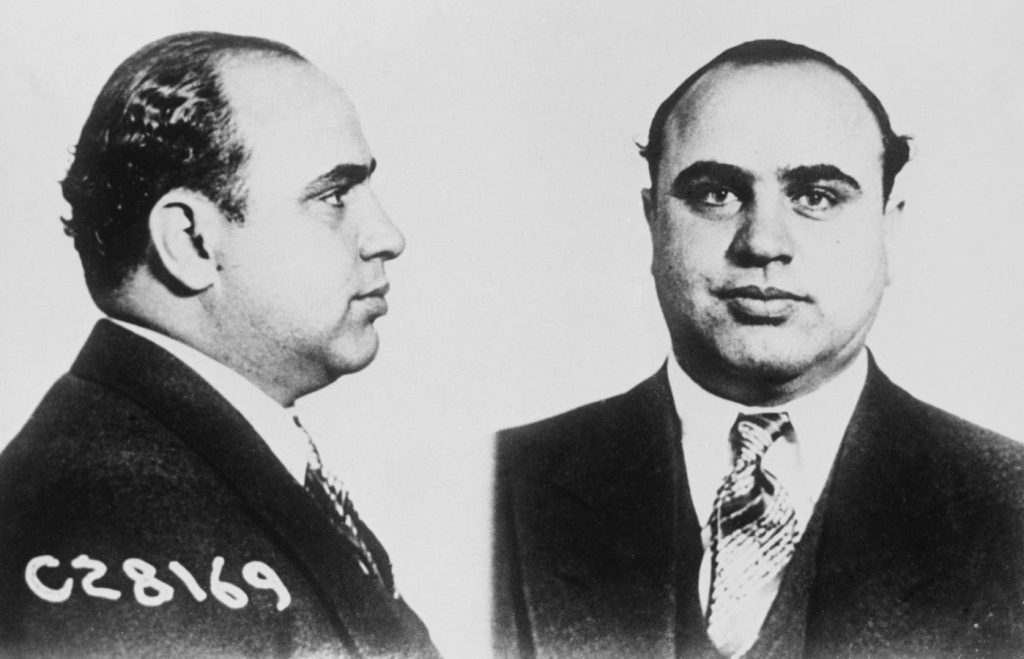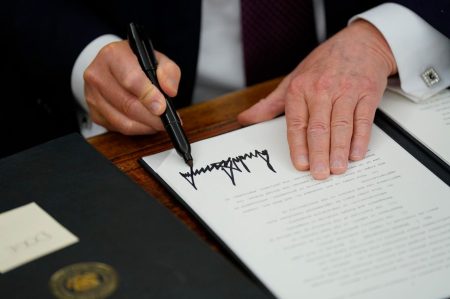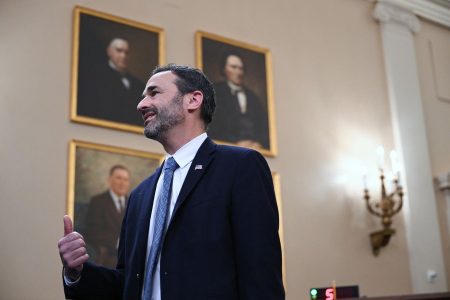On this day in 1931, Al Capone was found guilty of tax evasion. The gangster, who had reportedly boasted, “They can’t collect legal taxes from illegal money,” was sentenced to 11 years in prison for failing to file tax returns.
Humble Beginnings
Alphonse Gabriel Capone was born in Brooklyn, New York, in 1899 to Italian immigrants. His parents, Gabriele Capone and Teresa Raiola, found working-class jobs and settled into their new lives. Capone, however, had trouble fitting in and was expelled from school at age 14 for hitting a teacher.
After he left school, Capone tried his hand at odd jobs, but nothing stuck. Capone eventually turned to a friend, Johnny “The Fox” Torrio, who was just getting started building an empire. Torrio would go on to be called “the father of American gangsterdom” by Elmer Irey, the first chief of the Internal Revenue Service (IRS) Enforcement Branch, now referred to as the IRS Criminal Investigation Division, or IRS-CI.
Torrio introduced Capone to Frankie Yale—and his first real taste of the underworld. Yale, who owned several clubs where patrons could go to drink, gamble, and pay for sex, gave Capone a job as a bouncer and bartender. While at work, Capone, who wasn’t known for being even-tempered, got into a fight. During the melee, he was slashed across his left cheek three times with a knife, leaving a permanent scar and earning the nickname “Scarface.”Supposedly, the fight was over a girl.
At age 18, Capone met and married Mae Coughlin. Soon after, the couple had their first child, Albert Francis “Sonny” Capone. Sonny’s birth briefly gave Capone pause to consider making an honest living. The family moved to Baltimore, where Capone intended to become a bookkeeper—working the numbers on the right side of the law.
An Offer He Couldn’t Refuse
But Capone couldn’t resist the allure of the gangster life. When Torrio asked Capone to move to Chicago to help run his mob empire, it was an offer that Capone couldn’t refuse.
The dark side quickly caught up to Torrio. In 1925 he barely survived an assassination attempt by rival mobsters Hymie “The Pole” Weiss, Vincent “The Schemer” Drucci and George “Bugs” Moran. After spending three weeks in the hospital and even more time in prison, Torrio wanted out. He decided to leave Chicago, handing over control of his empire to Capone.
(Weiss’ attack on Torrio didn’t go unnoticed. In 1926, Weiss and his bodyguard were gunned down on the street while walking to fellow gangster Dion O’Banion’s flower shop on north State Street. The flower shop is gone, but Holy Name Cathedral remains across the street—you can still see the bullet holes today.)
Capone was naturally gifted at making money and quickly expanded the business. By the mid-1920s, he was reportedly taking home nearly $60 million annually ($1.1 billion in today’s dollars), and his wealth continued to grow, reportedly topping $100 million ($1.8 billion in today’s dollars).
U.S. v Sullivan
As Capone’s empire grew, so did his penchant for violence. The bodies piled up in Chicago, and most had Capone’s fingerprints all over them. The feds, however, couldn’t make charges of violence stick against Capone. But something that happened in 1927—miles away from Chicago—would prove to be a turning point. On May 16, 1927, the U.S. Supreme Court ruled in U.S. v. Sullivan that “[g]ains from illicit traffic in liquor are subject to the income tax would be taxable.” It was just the ruling the feds needed.
(Fun footnote: The Justices noted in Sullivan, “It is urged that if a return were made, the defendant would be entitled to deduct illegal expenses such as bribery. This by no means follows, but it will be time enough to consider the question when a taxpayer has the temerity to raise it.”)
“Get Capone”
In 1928, finally fed up with the violence, the Secretary of the Treasury, Andrew W. Mellon, summoned Irey and told him to simply “get Capone.”
Irey is said to have replied, on behalf of the IRS-CI, “We’ll get right on it.”
Valentine’s Day Massacre
Even as Irey was investigating Capone, the violence continued. The lawlessness culminated on February 14, 1929. Capone was in Miami at the time of the shootings but was immediately blamed for what came to be known as the St. Valentine’s Day Massacre.
On the day of the murders, witnesses saw four men enter the garage—two of the men were dressed as police officers. The “officers” ordered Moran’s gang to line up against the wall, where they were hit with a spray of machine-gun and shotgun bullets: 70 rounds of ammo were fired. All seven men inside died—most of them immediately.
One of the victims, alleged contract killer Frank Gusenberg, survived long enough to allegedly tell police, “No one shot me.”
What triggered the dispute? It was likely territory. Moran controlled the North Side of Chicago, while Capone controlled the South Side (sometimes called “The Outfit”). At the time, the city’s North, West, and South Sides were divided along the boundaries created by the Chicago River. The West Side was controlled by the Valley Gang, an Irish-American street gang that ultimately formed an alliance with Capone.
Moran escaped the violence, but just barely: He was late to the scene and missed the shootings by minutes. A few days later, he allegedly told reporters, “Only Capone kills like that.” It was a line so famous that it made it into the movies.
Capone allegedly responded, “The only man who kills like that is Bugs Moran.”
There were no witnesses who lived to tell the tale, no evidence, and no one was ever prosecuted. However, the feds believed that Capone was responsible, and in 1930, Capone was dubbed “Public Enemy Number One,” a label he reportedly hated (his older brother, Ralph “Bottles” Capone, would earn the title “Public Enemy Number Three”).
Capone grew more bold, believing that he was untouchable. He failed to answer a subpoena to appear before a federal grand jury, claiming he had bronchial pneumonia and was confined to bed rest.
He was arrested on contempt charges after prosecutors produced evidence that he had been gambling at the track and cruising in the Bahamas. He was released on bond but was re-arrested on concealed weapons charges and sentenced to prison at Philadelphia’s Eastern State Penitentiary, where he reportedly lived in luxury amid French furniture, plush rugs, and a Victrola radio in his cell.
Federal Tax Case
During this time, the feds were quietly building a case against Capone. Despite his public and extravagant lifestyle, Capone had never filed a federal income tax return, claiming he had no taxable income. IRS Special Agent Frank Wilson and the Treasury’s “T-Men” followed the money, gathering evidence that Capone had made millions of dollars on income that was never taxed. It paid off: Capone was indicted on 22 counts of federal income tax evasion.
Capone wasn’t the only one to be charged. His brother, Ralph, Jake “Greasy Thumb” Guzik, Frank Nitti and others were also charged. Capone bragged that he had reached a plea agreement that would have sent him to jail for just two years. The judge refused to accept the deal, and the case went to trial.
Capone was found guilty on October 17, 1931. One week later, on October 24, 1931, he was sentenced to a then-unheard-of 11 years in prison. He was fined $50,000 ($1,058,057 in today’s dollars), charged court costs, and ordered to pay back taxes of $215,000 (now $4,549,645).
He immediately appealed and was denied a rehearing.
Prison: From Atlanta To Alcatraz
Capone’s first prison stop after his conviction was Atlanta. Initially, he bribed prison officials to get what he wanted, just as he had done in Philadelphia. When officials found out what he had done, he was punished by being relocated to Alcatraz, the formidable prison built on a small island offshore from San Francisco, California. Alcatraz proved to be Capone’s undoing.
Alcatraz’ warden, James Aloysius Johnston, wasn’t as easily swayed as those prison officials Capone had previously encountered. When Johnston asked Capone his name, the mobster allegedly responded, “You know who I am.” Johnston is said to have retorted, “Here you are now known as AZ-85.”
Capone eventually admitted, “It looks like Alcatraz has got me licked.”
Capone spent more than four years at Alcatraz, where he worked doing jobs like laundry (as most grade school kids know, thanks to Gennifer Choldenko). During his sentence, his health eventually got the best of him: He had contracted syphilis years before, and it worsened, leading to “intermittent mental disturbances.”
In 1937, he again appealed his sentence, this time to District Court, arguing that his verdict had been inconsistent. The appeal was dismissed.
Capone moved again in 1939—this time to a mental hospital to serve out the remainder of his sentence before retiring to Florida. Before his death, his physician determined that he had deteriorated to the point where he had the mental capacity of a 12-year-old. Capone, once the most feared man in America, died on January 25, 1947, at the age of 48.
Read the full article here










